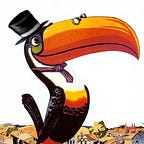Designing a “Cool S” for the Digital Age
Those of us who were raised in pre-internet days remember the “Cool S.” The Cool S is perhaps one of the last examples of what Richard “Dick” Dawkins originally meant by a “meme:” we saw it drawn on notebook paper, or doodled in the margins of worksheets, and could instantly grasp how it might be drawn. A few tries and missteps later, we could draw our own Cool S, where it would be observed by others, who would then imitate the Cool S in their own worksheet margins. The idea propagates, in an analog way, among populations and across barriers. We see the S and acknowledge it as cool. In acknowledging it, we see how it might be drawn, and create our own. The Cool S requires no backstory, no context. It cannot be subverted or inverted or deconstructed in the way that a modern internet meme can be: it is a Cool S, and so is joyfully and fully itself.
I have a bad habit of defaulting to doctrinaire Marxist historical materalism when I think about these things; still, it seems impossible for me to imagine the Cool S arising in a post-digital society. The material conditions of the internet age do not afford the Cool S. In the era of WikiHow and YouTube tutorials, where is the satisfaction of learning to draw the Cool S for yourself? What are the digital equivalents of the margins of worksheets, or the torn off pieces of composition notebooks? In an era where everything you have said or done becomes data that can be used to harm you, who would have the vulnerability to waste a page or two practicing the Cool S over and over until they get it right?
It is clear to me that the Cool S is a relic of the analog age: it cannot survive in our dystopian times. A new Cool S must have more in common with Deleuze and Guattari’s “war machine” than it does with mere typography: a nomadic and self-organizing engine that can weather whatever the digital age throws at it. In short, we need a new Cool S, and it falls to me to design it.
I believe the neo-Cool S must have the following features:
- It must be capable of being statically drawn. This leaves out animated S’s, or multimodal or multimedia S’s.
- It must be self-descriptive: from the appearance of the S, it must be clear how to recreate it. Like a cell, it must contain the instructions for its own replication within it.
- It should speak to or draw on our digital culture.
I present the following designs for feedback, but I welcome all critiques, constructive or otherwise: we must get this right, as a civilization.
The Interlinked S
The internet provides the illusion of connection. We believe that we are an active part of each others lives because Facebook prompts us to remember someone’s birthday, or allows us to argue with them about politics at the drop of a hat. Twitter and Instagram allow us to “follow” celebrities and build a false empathy with them by liking their post about a dog they saw, or laughing along with their jokes.
The interlinked S reflects this illusion with two U shapes that appear to meet, and cause us to perceive them both as part of a Gestalt “S”, but in fact are disparate, unconnected components. The Interlinked S also brings to mind the DNA double-helix or the yin-yang, both relevant symbols in an age of increasingly invasive data collection as well as increased polarization.
Sierpinski S
The modern internet is a fractal place, with hidden complexities and nested in-jokes. Why not, then, draw upon the Sierpinski gasket for construction of the new Cool S? The algorithmic method of drawing (draw the exterior Cool S, then draw the nested Cool Ss on each arm, repeating as necessary) also connects to the human-designed but inhumanly-applied algorithms and procedures that underpin the modern internet.
The D “Cool S” A
Drawing inspiration from the logo of the Democratic Socialists of America, this version of the Cool S uses the motif of clasped hands to speak to an aspirational unity, and the ability of the internet to bridge vast distances and bring together people from all walks of life. It also connotes that, in the long run, it’s going to be socialism or barbarism, and also that people are mad on the internet all the time. It also kind of reminds me of the goat man, so there’s another connection right there.
The Cool S Elite™
The digital divide has turned into a digital chasm as it begins to reflect the inequalities of class and material prosperity that are present in the world at large. People who pay money can skip ads, consume content earlier, and have qualitatively different experiences on the internet compared to those who can’t or won’t pay. The Cool S Elite™ reflects this gap by requiring you to give me money on my Patreon to see the S, and what it might be. Due to cognitive dissonance, you will then believe that this S is really cool indeed, or else why would you have spent money on it? You will still complain about it, though.
Conclusion
While all of these proposed replacement Cool Ss have their benefits, I am as yet unsatisfied. Please bring me any other potential Cool Ss. I am particularly interested in how digital media can afford new conceptions of hitherto unimagined Cool Ss. A collaborative Cool S, perhaps? Or a data-driven Cool S? Could Deep Learning be applied to this problem? These are the urgent questions of the age.
